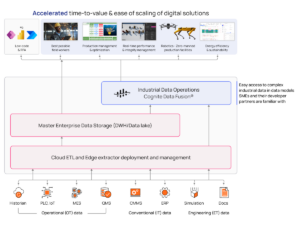
The power and utilities industry is now decades into digital transformation and many digital teams are under increasing scrutiny to determine their business impact. For those who have taken a do-it-yourself (DIY) approach to operational data and digital platforms, quantifying value and justifying complex multi-year investments has been difficult in the face of few adopted, scaled business solutions and increasing cost pressure.
Often, impact is only felt at a single lighthouse site that has few active daily business users. The inconsistent user experience of technical back-end first-designed platforms is not exactly making SMEs fight for self-service access to new capabilities. On the cost side, specialized full-time equivalent (FTE) skillsets and armies of consultants continue to inflate the total cost of ownership (TCO) that is felt in both development and ongoing maintenance of DIY platforms. By keeping cloud costs equal, the scale and economical benefits of Software-as-a-Service (SaaS) offer an intriguing alternative.
So what can we learn from this DIY history? Let’s start by unpacking a few myths:
Myth 1: DIY is the only enterprise-grade path
Enterprise SaaS is every bit as enterprise-grade as the first-party public cloud services that are used to develop a custom made Data & Digital Platform. The only difference is that while enterprise SaaS comes with comprehensive service level agreement (SLA) and premium support options, with DIY, you are responsible for your own SLA and support. When it comes to supporting thousands of users, having a strong user community and documentation – all table stakes with enterprise SaaS – warrant serious consideration. Enterprise-grade means ready for enterprise-scale usage.
Moreover, enterprise SaaS comes with coherent, well researched, painstakingly tested and iterated, business-user-persona-based UX. Key to driving user adoption and subsequent value, what could your SMEs accomplish with google-like search of industrial data?
Myth 2: DIY is the only way to avoid vendor lock-in
One of the more ironic arguments going around is that going all-in with one cloud and DIY-ing everything using that cloud’s proprietary services will protect against vendor lock-in. The truth is, your enterprise is already multi-cloud and will be more so going forward. Cisco Systems Inc.’s 2022 Global Hybrid Cloud Trends survey found that 82% of IT leaders have adopted a hybrid cloud while just 8% use only a single public cloud platform.
The same applies to your SaaS choices. Working with specialists gives you access to the relative strengths of different partners. It allows you to compensate for lack of a specific capability by one, with that of another, while maintaining your flexibility of choice.
Openness, focus on industry standards for data exchange and data models, and placing partner ecosystems — including frenemy ecosystems — at the center of customer value delivery are not unique to clouds; this is normative business hygiene for all of 2020s enterprise SaaS.
Myth 3: DIY is what innovators do
Being innovative means doing things differently or doing things that have never been done before. Innovators drive business impact and operational change, challenge the status quo, and take calculated risks to ensure their business is on the right side of history.
For Data & Digital Platforms, innovators are not repeating pre-cloud, pre-SaaS era, bespoke software development practices, but instead are turning their sights to the growing number of readily available SaaS industry cloud platforms, according to Gartner[1]:
- Are designed to meet the specific needs of vertical industry segments that are inadequately served by generic solutions;
- Turn a cloud platform into a business platform;
- Pointedly appeal to business consumers beyond the early users of cloud infrastructure and platform technologies;
- Add value by using innovative technologies and approaches, such as packaged business capabilities, industry-aware data fabrics and composable tooling to go beyond traditional cloud platforms and create added value.
Gartner predicts that by 2027, enterprises will use industry cloud platforms to accelerate more than 50% of their critical business initiatives, whereas in 2021, that percentage was less than 10%. For business-value-obsessed-technology leaders, this enterprise SaaS path is innovation.
Myth 4: DIY gives me job security
The best means of creating job security and establishing value for your department and your team is to create business impact that aligns with your company’s strategic priorities and values. Delivering real business value to your business operations is the most direct, measurable and visible way of doing so.
It also is worth noting that your business operations people do not care what brand of tooling you use. They only care that it makes their day-to-day lives easier, allows them to gain better situational awareness on events in real-time, and make better business decisions. They really do not care if it is DIY-built, SaaS, or hybrid. They do care that it is fit for purpose, easy-to-use, and makes their life easier.
In different times, starting a promising, multi-year, 3-figure ($M) strategic DIY platform project was aspirational. Today, with the majority of those 3-figures spent without much ROI to show for it, focusing on here-and-now value to business is the best job security plan.
One Logical Conclusion:
With all likelihood, your company is not turning into a software platform company, but it is and will remain a power and utilities company.
While DIY industrial data and digital platform development feels like the safer option, utilities must seriously consider the business case for SaaS and hybrid approaches for all of the aforementioned reasons. Thinking outside of the DIY box helps cement digital teams as strategic forces for driving sustained operational change.
Meeting business needs today – and anticipating business needs of tomorrow – is strategic. It is important to find agile solutions to business needs that deliver value quickly, are easy for business users to adopt and scale; are open, interoperable and extendable; and are flexible to onboard, maintain and offboard if needed.
As we like to say at Cognite: Some digital teams reshape organizations. Others play in sandboxes. Which one are you?
Hybrid Data Platform Reference Architecture:

[1] Gartner, What Are Industry Cloud Platforms? , September 21, 2022

Rodney Durban has over two decades experience working inside and with electric utility companies to solve the data problem and currently leads Cognite’s power and renewables business in the Americas.














